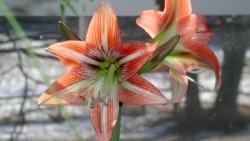Indoor plants are a beautiful way to brighten up your home, especially in the gray months of winter.
But there can be a dark side to houseplants if you have children or if children visit your home. It is important that you know which plants are toxic to young, curious humans.
Gardening expert Jessica Damiano recently wrote about the issue for The Associated Press. She said she often points out houseplants in friends’ homes that should be kept out of children’s mouths. “I don’t mind dashing friends’ hopes of an Instagram-worthy indoor jungle if it means…preventing harm,” Damiano wrote.
Kaitlyn Brown works at America’s Poison Centers in Arlington, Virginia. She told the AP, “We get an average of 33,000 calls a year from people whose kids put different plants in their mouths.”
She added that the cases usually involve children under 3, “because they explore their environment," she said, "and they put everything in their mouths.”
Most accidental exposures are not serious, Brown said. But in some cases a child’s breathing, skin and eyes can be badly harmed.
Damiano wrote that she recently visited her cousin’s home and saw a Dieffenbachia plant in the kitchen. Her cousin told her that her young son, who had just begun crawling, had shown interest in the leaves.
Damiano had to explain to her cousin that eating a small amount of the plant’s stem can cause temporary but severe pain. The plant parts can cause throat and mouth swelling. The plant’s sap can cause nose, skin and eye pain.
Other plants that can cause similar reactions include: Caladium, flamingo flower, Swiss cheese plant, peace lily, ZZ plant, philodendron and pothos.
Amaryllis and its relatives including clivia and daffodil, contain lycorine, a toxic substance that can cause a range of stomach issues.
Damiano wrote that parents should teach their young children not to put non-food plant parts into their mouths. Parents should also educate themselves, she said. She urges parents to research whether the plants in their homes are safe to grow around children. She also suggests learning the official botanical names of any houseplants so that they are able to provide that information quickly to a poison control expert, if needed.
Not all houseplants are problematic, of course. Spider plants (Chlorophytum comosum) are nontoxic and are also among the easiest indoor plants to grow.
African violets, Boston ferns, Christmas cactus, waxplants, parlor palms, radiator plants, prayer plants and baby’s tears are other safe choices.
I’m Ashley Thompson.
Jessica Damiano reported this story for The Associated Press. Ashley Thompson adapted it for VOA Learning English.
_______________________________________________________________________
Words in This Story
dash - v. to destroy or ruin (something, such as a hope or an expectation)
exposure - n. the fact or condition of being affected by something or experiencing something : the condition of being exposed to something
swelling - n. the condition of being larger than normal










Forum